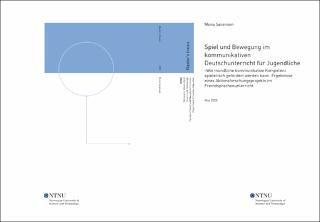| dc.contributor.advisor | Bauer, Karen | |
| dc.contributor.author | Sørensen, Mona | |
| dc.date.accessioned | 2021-09-28T17:44:56Z | |
| dc.date.available | 2021-09-28T17:44:56Z | |
| dc.date.issued | 2020 | |
| dc.identifier | no.ntnu:inspera:55578580:16428685 | |
| dc.identifier.uri | https://hdl.handle.net/11250/2784843 | |
| dc.description.abstract | I en digital hverdag er bevegelse stadig viktigere i et folkehelseperspektiv. Dette gjelder også i skolesammenheng. Ordet “spill” er i utgangspunktet etymologisk karakterisert av bevegelse. Likevel har det oppstått et hull i forskningen på fysiske spill. Det er knapt noen referanser til studier av bevegelsesspill i fremmedspråksundervisningen.
Målet for dette forskningsarbeidet er å undersøke fysiske spill som didaktisk og muntlig-kommunikativ metode i tysk som fremmedspråk for ungdom.
Masterarbeidet er viser til resultater fra et aksjonsforskningsprosjekt ved en videregående skole i Norge, og stiller seg spørsmålet hvordan muntlig kommunikativ kompetanse kan fremmes gjennom to fysiske læringsspill. Bakgrunnen for forskningen var de generelle kommunikative problemene som oppstod ved spontane samtaler i ordinær undervisning. For å forbedre situasjonen ble muntlige og fysiske spill valgt som didaktisk metode.
For å svare på forskningsspørsmålet ble en undervisningsplan som inkluderte de fysiske spillene implementert i en tyskklasse. Spillteori og teorier om kommunikativ kompetanse ble innhentet fra vitenskapelige og pedagogiske kilder før en aksjonsplan ble laget. Observasjoner fra klassen, en umiddelbar samtale med observatørene, et spørreskjema ble fylt ut av observatørene og forskningsdeltakerne, og et semi-strukturert intervju med forskningsdeltakerne ble utført. Dataene ble analysert og tolket i lys av en refleksjon og profleksjon fra forskeren.
På tross av de åpenbare problemene ved aksjonsforskning som metode, peker den kvalitative forskningen i dette masterarbeidet på interessante resultater, fordi data innhentet ved ulike metoder gir mulighet for triangulering av kildene.
Svarene på intervjuene og spørreskjemaene, samt observasjonene i klasserommet, viser at de utprøvde bevegelsesspillene har et kommunikativt og studentsentrert potensial. Formen i de fysiske spillene bidrar til en motivasjonal variasjon i klasserommet. Gjennom den uformelle situasjonen som karakteriseres ved spill forsvant unnvikelsesstrategier. Den kommunikative kompetansen ble fremmet bade hos sterke og svakere elever. Likevel er metodene spesielt å anbefale for elever som har vanskeligheter med å fokusere, fordi fysisk aktivitet bidrar til helhetlig læring.
Profleksjonen i arbeidet viser at lærere trenger mer tid til å ta inn, prøve ut og dele spillbaserte metoder i sin undervisning. Den metodiske variasjonen er fremhevet som viktig for elevene. Hvis dette skal hensyntas er det å anbefale at administrasjonen ved norske skoler legger til rette for at lærere får nok tid til å samarbeide faglig og tverrfaglig for å dele erfaringer og utvikle fysiske metoder for fremmedspråksundervisning. | |
| dc.description.abstract | In a digital workday, the movement of the body becomes more and more important for the public health. This also applies to in schools. The word «game» is initially characterized by movement. Yet there has arisen a gap in the scientific literature when it comes to physical games. There are hardly any references to studies of physical games in the foreign language classes.
The goal of this research is to examine physical games as didactical and oral-communicative methods in German as a foreign language for youth.
This thesis is supported by results from an action research project at an upper secondary school in Norway, and it asks the question how oral communicative competence can be promoted through two physical games. The background was the general communicative problems in spontaneous conversations, evident in regular education. To improve the situation, oral and physical games were chosen as didactic method.
To answer the research question, an education plan including physical games was implemented and observed in a German as foreign language class. Game theories and theories about communicative competence were collected from scientific as well as pedagogical sources before an action plan was made. Observations from class, an immediate conversation with the observers, a questionnaire for the observers and participants, and a semi-structured group-interview with the students were carried out. The data was analysed and interpreted considering a reflection and a pro-flection from the researcher.
Despite the obvious problems in action research, the qualitative research in this thesis point to interesting results, because data gathered through different methods gives the opportunity of triangulation.
The answers of the questionnaires and the interviews, as well as the observations in the classroom, show that the games have a communicative and student-centred potential. The form of the physical games also creates a motivational variety in the classroom. Through the informal situation that characterize games, strategies for evasion disappeared. The communicative competence was challenged both with strong and weak students. Still the methods are especially recommended for students that have difficulties focusing, because the physical action contributes to general learning.
The pro-flextion of this thesis show that teachers need more time to embed, try out and share game-based methods in their education. The methodical variety is described as crucial for the students. Considering this, it is recommended that the administration in Norwegian schools make sure that teacher get enough time to cooperate professionally as well as cross-disciplinary to share experiences and further develop about physical methods. | |
| dc.language | | |
| dc.publisher | NTNU | |
| dc.title | Spiel und Bewegung im kommunikativen Deutschunterricht für Jugendliche | |
| dc.type | Master thesis | |
